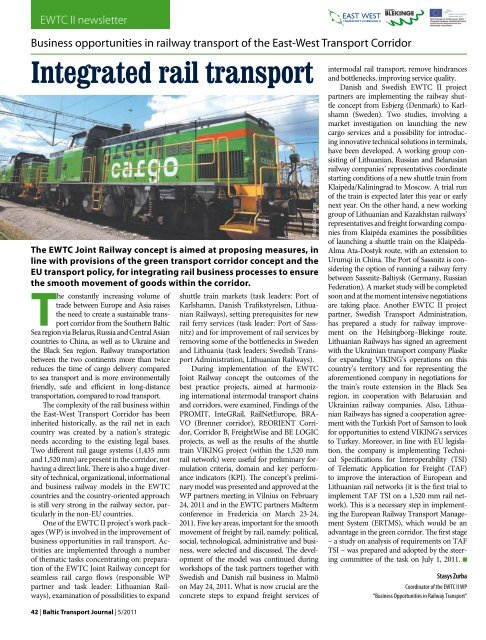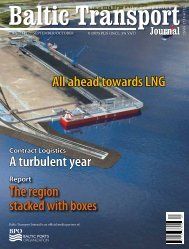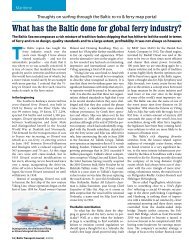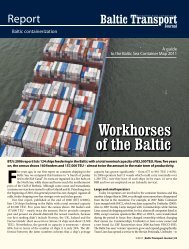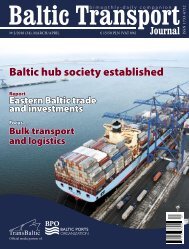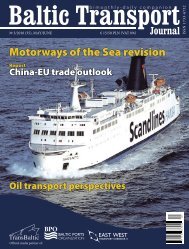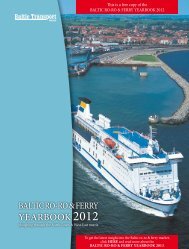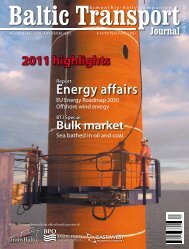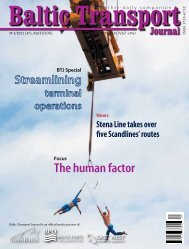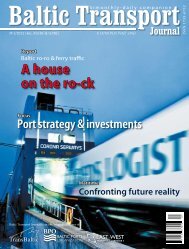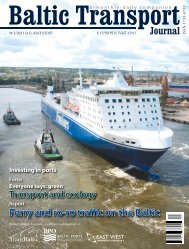BTJ 5/2011 - Baltic Press
BTJ 5/2011 - Baltic Press
BTJ 5/2011 - Baltic Press
- No tags were found...
Create successful ePaper yourself
Turn your PDF publications into a flip-book with our unique Google optimized e-Paper software.
EWTC II newsletterBusiness opportunities in railway transport of the East-West Transport CorridorIntegrated rail transportThe EWTC Joint Railway concept is aimed at proposing measures, inline with provisions of the green transport corridor concept and theEU transport policy, for integrating rail business processes to ensurethe smooth movement of goods within the corridor.The constantly increasing volume oftrade between Europe and Asia raisesthe need to create a sustainable transportcorridor from the Southern <strong>Baltic</strong>Sea region via Belarus, Russia and Central Asiancountries to China, as well as to Ukraine andthe Black Sea region. Railway transportationbetween the two continents more than twicereduces the time of cargo delivery comparedto sea transport and is more environmentallyfriendly, safe and efficient in long-distancetransportation, compared to road transport.The complexity of the rail business withinthe East-West Transport Corridor has beeninherited historically, as the rail net in eachcountry was created by a nation’s strategicneeds according to the existing legal bases.Two different rail gauge systems (1,435 mmand 1,520 mm) are present in the corridor, nothaving a direct link. There is also a huge diversityof technical, organizational, informationaland business railway models in the EWTCcountries and the country-oriented approachis still very strong in the railway sector, particularlyin the non-EU countries.One of the EWTC II project’s work packages(WP) is involved in the improvement ofbusiness opportunities in rail transport. Activitiesare implemented through a numberof thematic tasks concentrating on: preparationof the EWTC Joint Railway concept forseamless rail cargo flows (responsible WPpartner and task leader: Lithuanian Railways),examination of possibilities to expand42 | <strong>Baltic</strong> Transport Journal | 5/<strong>2011</strong>Photo: Green Cargoshuttle train markets (task leaders: Port ofKarlshamn, Danish Trafikstyrelsen, LithuanianRailways), setting prerequisites for newrail ferry services (task leader: Port of Sassnitz)and for improvement of rail services byremoving some of the bottlenecks in Swedenand Lithuania (task leaders: Swedish TransportAdministration, Lithuanian Railways).During implementation of the EWTCJoint Railway concept the outcomes of thebest practice projects, aimed at harmonizinginternational intermodal transport chainsand corridors, were examined. Findings of thePROMIT, InteGRail, RailNetEurope, BRA-VO (Brenner corridor), REORIENT Corridor,Corridor B, FreightWise and BE LOGICprojects, as well as the results of the shuttletrain VIKING project (within the 1,520 mmrail network) were useful for preliminary formulationcriteria, domain and key performanceindicators (KPI). The concept’s preliminarymodel was presented and approved at theWP partners meeting in Vilnius on February24, <strong>2011</strong> and in the EWTC partners Midtermconference in Fredericia on March 23-24,<strong>2011</strong>. Five key areas, important for the smoothmovement of freight by rail, namely: political,social, technological, administrative and business,were selected and discussed. The developmentof the model was continued duringworkshops of the task partners together withSwedish and Danish rail business in Malmöon May 24, <strong>2011</strong>. What is now crucial are theconcrete steps to expand freight services ofintermodal rail transport, remove hindrancesand bottlenecks, improving service quality.Danish and Swedish EWTC II projectpartners are implementing the railway shuttleconcept from Esbjerg (Denmark) to Karlshamn(Sweden). Two studies, involving amarket investigation on launching the newcargo services and a possibility for introducinginnovative technical solutions in terminals,have been developed. A working group consistingof Lithuanian, Russian and Belarusianrailway companies’ representatives coordinatestarting conditions of a new shuttle train fromKlaipėda/Kaliningrad to Moscow. A trial runof the train is expected later this year or earlynext year. On the other hand, a new workinggroup of Lithuanian and Kazakhstan railways’representatives and freight forwarding companiesfrom Klaipėda examines the possibilitiesof launching a shuttle train on the Klaipėda-Alma Ata-Dostyk route, with an extension toUrumqi in China. The Port of Sassnitz is consideringthe option of running a railway ferrybetween Sassnitz-Baltiysk (Germany, RussianFederation). A market study will be completedsoon and at the moment intensive negotiationsare taking place. Another EWTC II projectpartner, Swedish Transport Administration,has prepared a study for railway improvementon the Helsingborg–Blekinge route.Lithuanian Railways has signed an agreementwith the Ukrainian transport company Plaskefor expanding VIKING’s operations on thiscountry’s territory and for representing theaforementioned company in negotiations forthe train’s route extension in the Black Searegion, in cooperation with Belarusian andUkrainian railway companies. Also, LithuanianRailways has signed a cooperation agreementwith the Turkish Port of Samson to lookfor opportunities to extend VIKING’s servicesto Turkey. Moreover, in line with EU legislation,the company is implementing TechnicalSpecifications for Interoperability (TSI)of Telematic Application for Freight (TAF)to improve the interaction of European andLithuanian rail networks (it is the first trial toimplement TAF TSI on a 1,520 mm rail network).This is a necessary step in implementingthe European Railway Transport ManagementSystem (ERTMS), which would be anadvantage in the green corridor. The first stage– a study on analysis of requirements on TAFTSI – was prepared and adopted by the steeringcommittee of the task on July 1, <strong>2011</strong>. Stasys ZurbaCoordinator of the EWTC II WP“Business Opportunities in Railway Transport”


